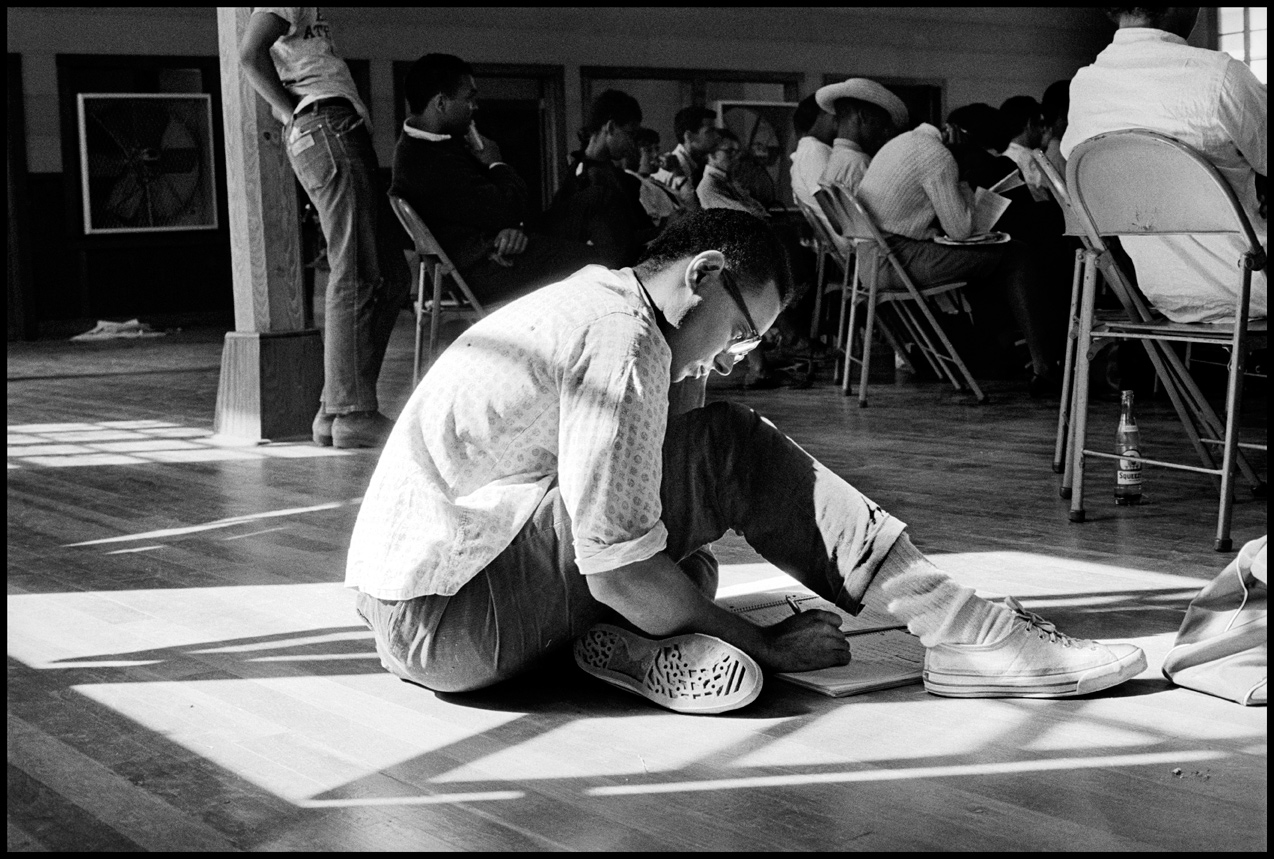November 1964
SNCC’s Waveland conference
SNCC was struggling with how best to move forward, and in November 1964, field staff and others working with the organization gathered in Waveland, Mississippi for a week-long “reassessment” conference. “We are a boat in the middle of the ocean,” wrote Bob Moses, SNCC’s Mississippi project director. The boat “has to be rebuilt in order to stay afloat. It also has to stay afloat in order to be rebuilt.”

Bob Moses at SNCC conference in Waveland, MS, November 1964, Danny Lyon, dektol.wordpress.com
1964 was an important year for SNCC. The group organized the large-scale Freedom Summer project, which brought almost one thousand volunteers to Mississippi to participate in Freedom Schools, voter registration efforts, and to help build the Mississippi Freedom Democratic Party. The project culminated when the Freedom Democrats sent a delegation to the Democratic Party’s national convention in Atlantic City to challenge the seating of Mississippi’s regular party delegation. The challenge failed.
The Democratic Party’s failure to seat the MFDP delegation left many SNCC organizers bitter with the betrayal. Their attempt to play by the rules of democracy was met with public rebuttal by national political leaders and even leaders within the Movement. Consequently, many SNCC workers lost interest in working within the Democratic Party establishment. Meanwhile, factions had begun to develop and have greater impact on the organization, although Cleveland Sellers pointed out, “there were always struggles around philosophy, around direction, around tactics, around strategy, continuously. It was a growth process.”

Jean Wheeler Smith and Jack Minnis (far right) at SNCC conference in Waveland, MS, November 1964, Danny Lyon, Memories of the Southern Civil Rights Movement 163, dektol.wordpress.com
That year had seen many changes and new pressures. The Mississippi summer project had brought a large number of new people into the organization. “Up to 1964, SNCC was primarily a small organization,” Sellers explained. Now the organization’s staff had swelled to 170 and its budget had jumped to over $200,000.
Battle fatigue and the accompanying tensions because of it was another factor. Psychiatrist Robert Coles, who spent time in Mississippi during the summer of 1964, reported that “in many ways these young civil rights workers are in a war and exposed to the stresses of warfare.” Stokely Carmichael recalled, “All of us were physically exhausted from the sheer burden of all the organizing work” that went into forming the MFDP.
These all underlay SNCC’s decision to scheduled the Waveland retreat. There was a “need for the entire staff to meet, sit down, and deeply analyze the essence of the organization and its relationship to the communities in which we work,” explained Ivanhoe Donaldson.
The conference was broken up into workshops to initiate conversations around SNCC’s goals, programs, and structure. Attendees were encouraged to think about fundamental questions like “Who are we working for and how do we work in the field?” and “What does it mean to be revolutionary?” Position papers were written and discussed. Over 40 papers were presented. They looked at a range of issues such as the role of education in organizing, the role of women in the organization, and the issue of race among the staff.

Courtland Cox, Phyllis Cunningham, Worth Long at SNCC conference in Waveland, MS, November 1964, Danny Lyon, Memories of the Southern Civil Rights Movement 163, dektol.wordpress.com
Much of the discussion also focused on SNCC’s organizational structure, strained because of the growing number of people in its ranks. According to Stokely Carmichael, “SNCC’s usual process of decision-making became unworkable.” Some in SNCC wanted to create a strong centralized decision-making body that emphasized planning and increased authority by its national headquarters in Atlanta. Proponents of this position felt that the only way to achieve internal unity and cohesion was through a centralized executive body.
Others believed that SNCC should remain a decentralized cadre of organizers in the field, with authority primarily lodged in the organizing of local projects. This, they felt, continued “the tradition, the climate, the forum for the exploration of ideas about our work and the problems we face.” This difference of opinion was never resolved.
For some, the Waveland Conference signaled that the democratic interracial culture that SNCC had cultivated since its founding was beginning to fray. As one staffer put it, “the circle of trust” that characterized SNCC was broken. Other staffers left the conference more optimistic about the future. Cleve Sellers remembered, “We didn’t answer all of the questions, it was impossible to do that,” but “we returned to our various outposts afterward with a better sense of who we were.”
Sources
Stokely Carmichael with Ekwueme Michael Thelwell, Ready for Revolution: The Life and Struggles of Stokely Carmichael (New York: Scribner, 2003), 415-438.
John Dittmer, Local People: The Struggle for Civil Rights in Mississippi (Urbana: University of Illinois Press, 1994), 315-337.
James Forman, The Making of Black Revolutionaries (Seattle: University of Washington Press, 1997), 411-432.
Cheryl Lynn Greenberg, ed., A Circle of Trust: Remembering SNCC (New Brunswick: Rutgers University Press, 1998), 155-160.
Wesley Hogan, Many Minds, One Heart: SNCC’s Dream for a New America (Chapel Hill: The University of North Carolina Press, 2007), 197-218.




